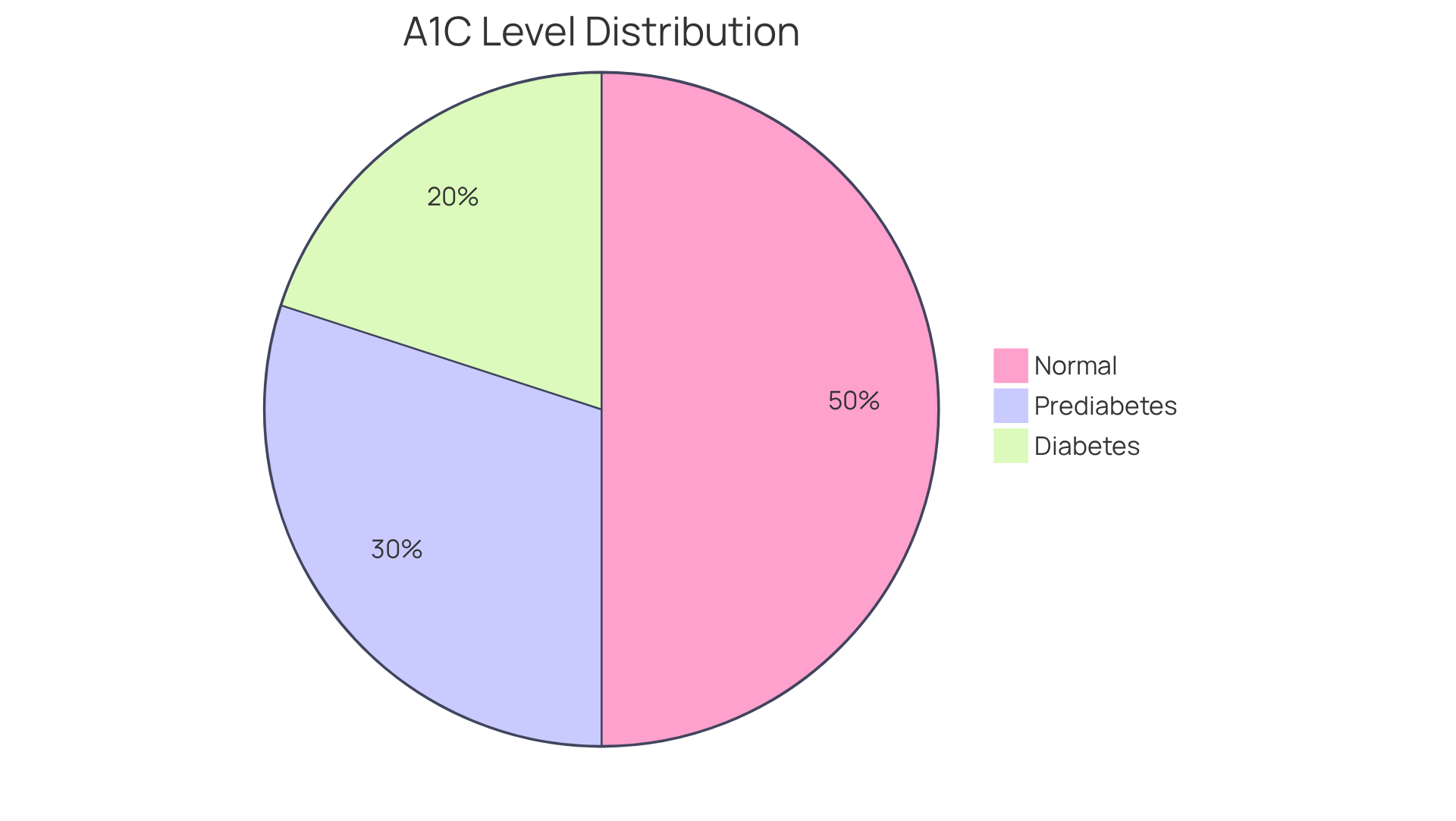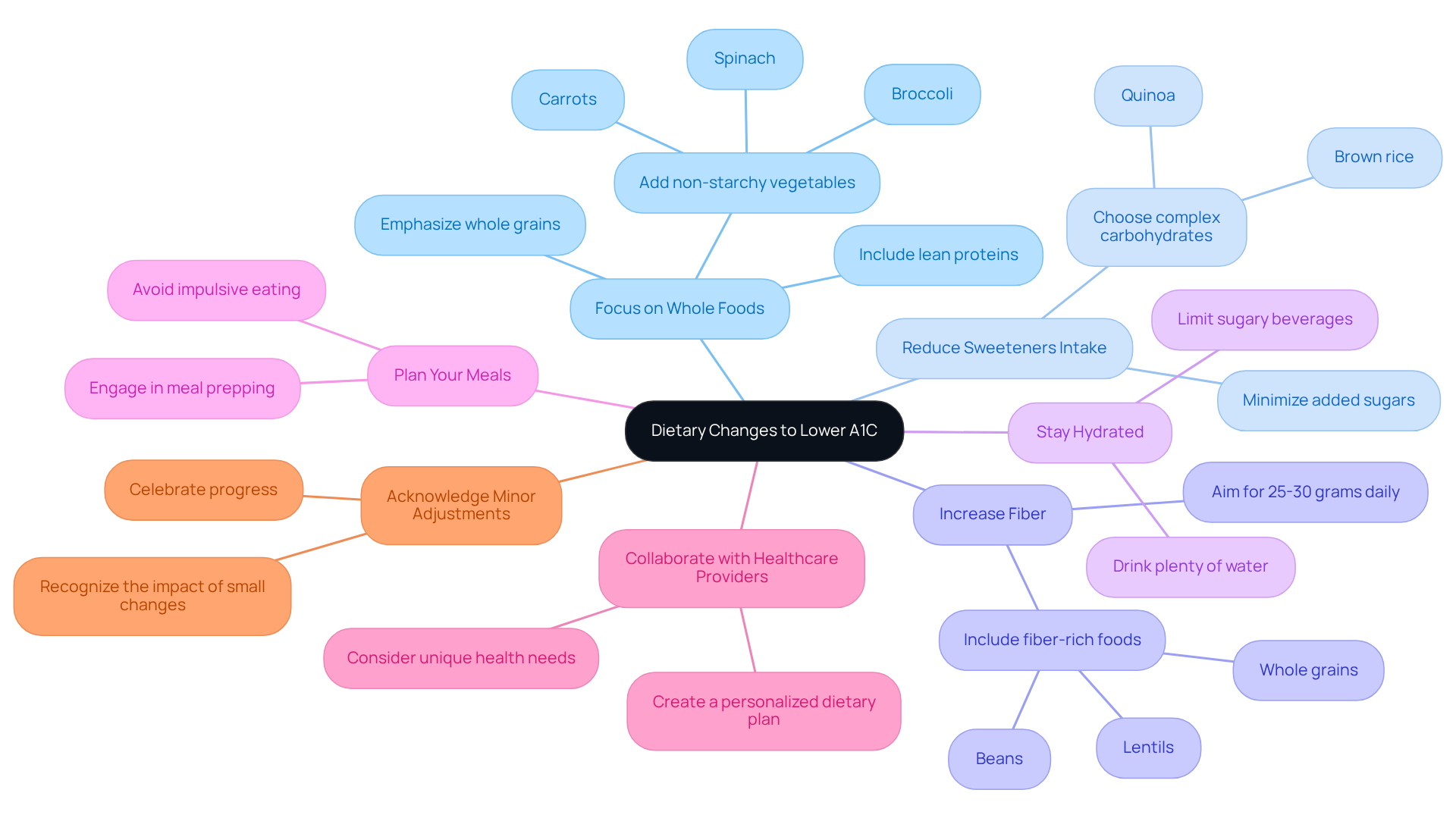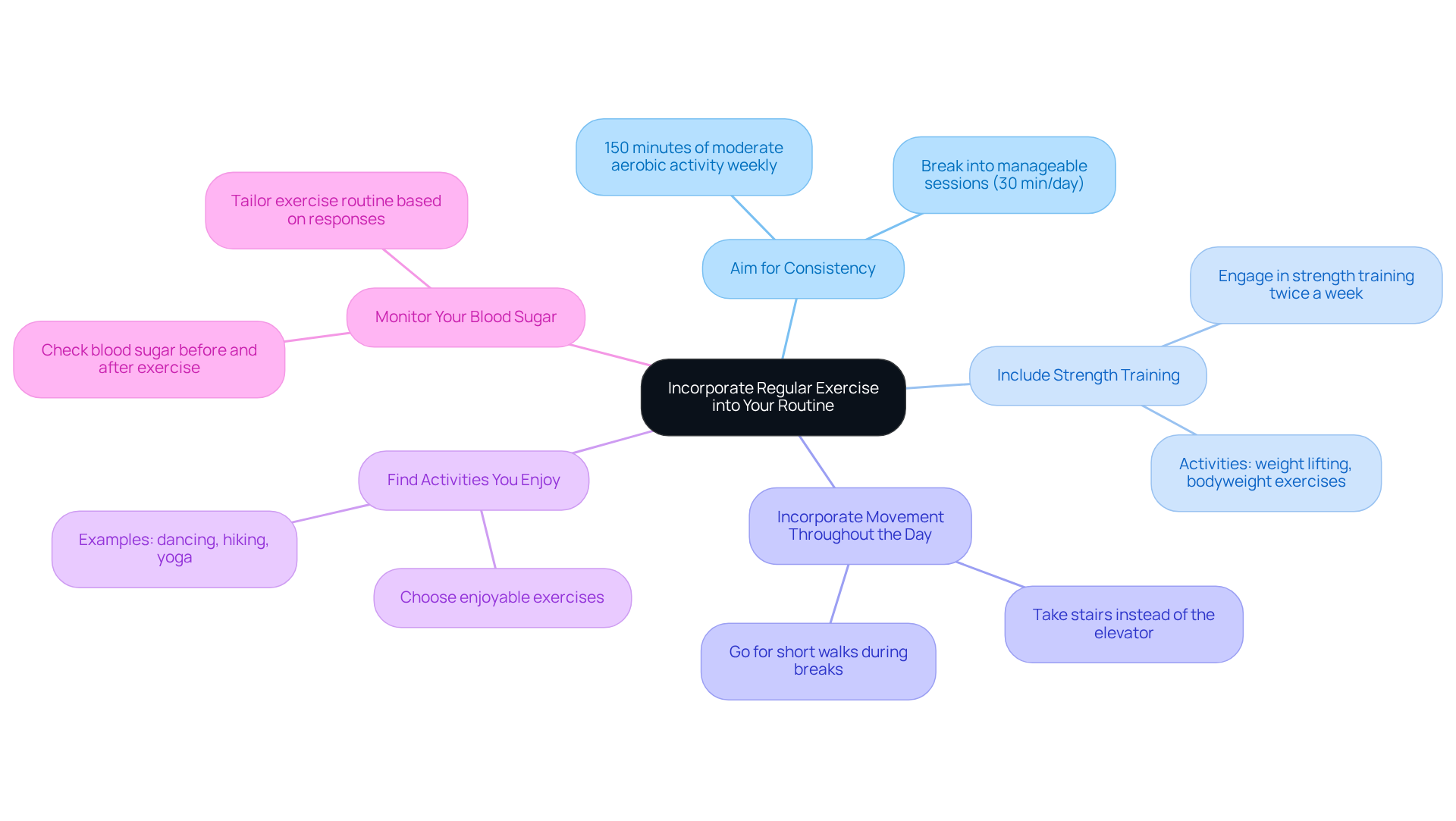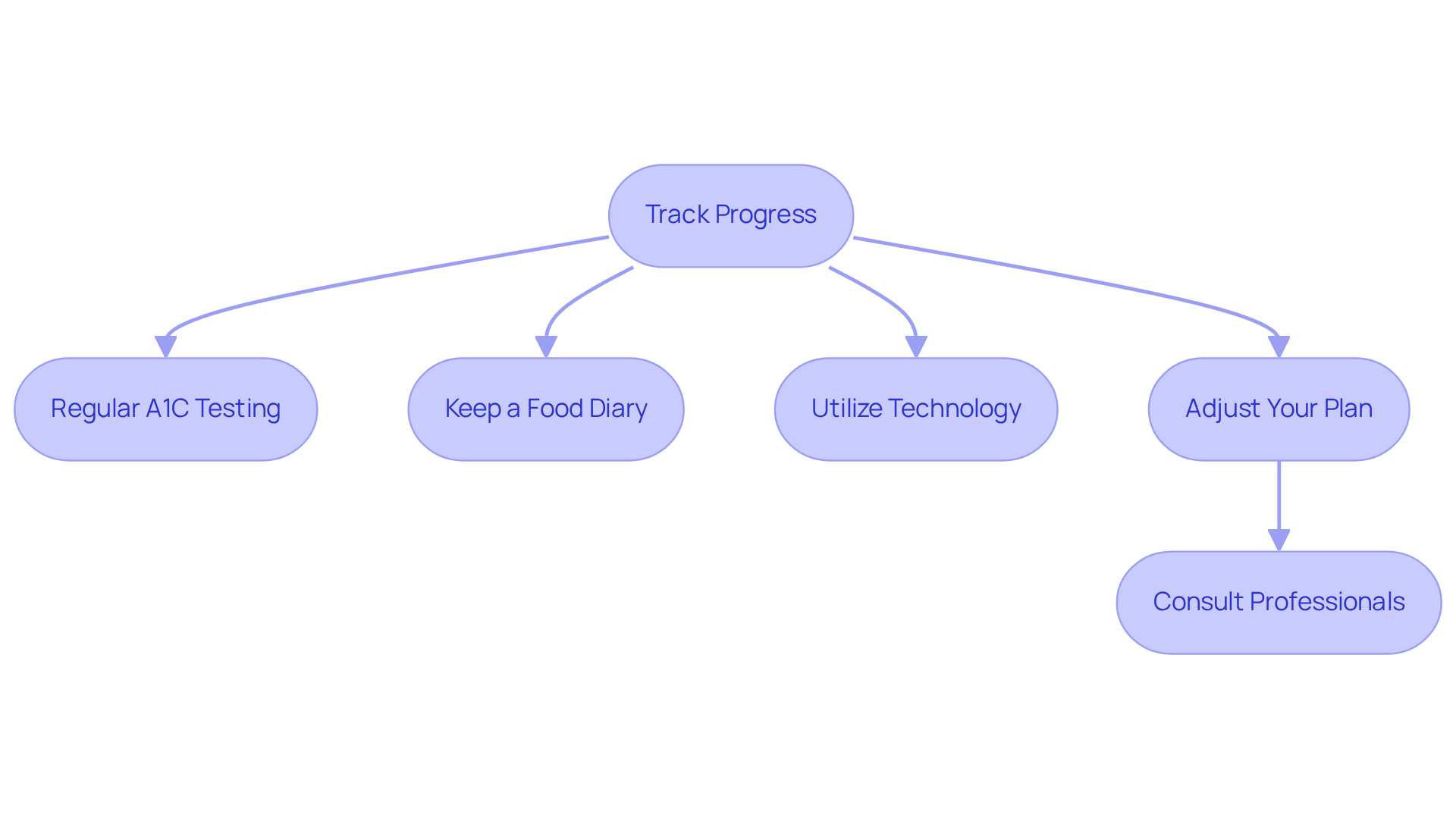Overview
If you’re looking to lower your A1C levels quickly and effectively, know that you’re not alone on this journey. Many individuals face similar challenges, and together, we can achieve your goals. Implementing dietary changes, engaging in regular exercise, and consistently tracking your progress are essential steps that can make a significant difference.
Consider focusing on whole foods that nourish your body and increasing your fiber intake to support your health. Incorporating strength training into your routine can also enhance glucose regulation and overall health management. Remember, every small change counts, and your efforts are truly commendable.
As you embark on this path, reflect on how these strategies resonate with your own experiences. What changes can you start making today? By taking these steps, you’re not just working towards better health; you’re also embracing a lifestyle that supports your well-being. We’re here for you, cheering you on every step of the way!
Introduction
Understanding A1C levels is crucial for anyone looking to manage their health effectively, especially given the alarming statistic that about 1 in 10 adults in the U.S. has diabetes. It’s natural to feel overwhelmed by this information. This article delves into actionable strategies to lower A1C quickly and effectively, offering you a roadmap to healthier living through:
- Dietary changes
- Exercise
- Progress tracking
But what if the key to preventing diabetes-related complications lies not just in medication, but in simple lifestyle adjustments that anyone can implement? Together, we can explore these changes and support each other on this journey toward better health.
Understand A1C and Its Importance
A1C, or hemoglobin A1C, is an essential blood test that assesses your average blood sugar readings over the past two to three months, expressed as a percentage. Normal A1C values are below 5.7%, while readings between 5.7% and 6.4% indicate prediabetes, and figures of 6.5% or higher suggest diabetes. Understanding your A1C is crucial, as it directly correlates with the risk of diabetes-related complications, including heart disease and nerve damage. Did you know that about 1 in 10 adults in the U.S. has diabetes? Many more are at risk due to prediabetes. Consistent tracking of A1C readings can guide essential lifestyle adjustments and medical actions that are crucial for lowering A1C fast, ultimately helping you preserve optimal health.
At Minimal, we’re here for you with a comprehensive approach to managing A1C values through our integrated wellness solutions. Our weight loss prescriptions, such as Semaglutide, combined with personalized fitness training, dietitian consultations, and nutrition guidance, empower you to make sustainable health improvements. Together, we can achieve your goals. Additionally, our alternative treatments, including breathwork, functional medicine, and continuous glucose monitoring, support your overall well-being.
Case studies show that individuals who focus on lowering A1C fast through these lifestyle modifications, including our services, can significantly reduce their risk of complications. This emphasizes the importance of consistent monitoring and proactive health management. Remember, you’re not alone in this journey; we’re here to support you every step of the way.
Implement Dietary Changes to Lower A1C
To effectively lower your A1C levels, it’s essential to make targeted dietary changes that can truly support your journey:
-
Focus on Whole Foods: Emphasizing whole grains, lean proteins, and a variety of non-starchy vegetables can make a significant difference. Imagine filling half your plate with nutrient-dense options like spinach, broccoli, and carrots. These foods are not only low in calories but also high in essential nutrients, helping you feel nourished and satisfied.
-
Reduce Sweeteners Intake: Have you considered minimizing added sweet substances and refined carbohydrates? By choosing intricate carbohydrates like quinoa and brown rice, which possess a lower glycemic index, you can assist in keeping your glucose concentrations stable.
-
Increase Fiber: Striving for a daily intake of 25-30 grams of fiber is a wonderful goal. Foods high in fiber, such as beans, lentils, and whole grains, play a crucial role in stabilizing glucose levels and enhancing overall glycemic regulation.
-
Stay Hydrated: Staying hydrated is key! Make sure to drink plenty of water while limiting sugary beverages. Adequate hydration supports your body’s ability to regulate glucose concentrations efficiently, contributing to your overall well-being.
-
Plan Your Meals: Engaging in meal prepping can be a game-changer. By having healthy meals readily available, you can avoid impulsive eating, significantly enhancing your adherence to dietary goals and promoting better blood sugar management.
-
Collaborate with Healthcare Providers: Working with your healthcare provider to create a personalized dietary plan can truly empower you. This partnership takes your unique health needs into account, which is essential for lowering A1C fast and achieving more effective control of your A1C readings.
-
Acknowledge the Effect of Minor Adjustments: Remember, even slight decreases in A1C values can lead to substantial health enhancements. Your dietary modifications matter, and every small step counts on your journey to better health. Together, we can achieve your goals, and we’re here for you every step of the way.
Incorporate Regular Exercise into Your Routine
Incorporating regular exercise into your routine can be an effective method for lowering A1C fast. It’s understandable to feel overwhelmed, but these effective strategies can help you make a positive change:
- Aim for Consistency: Strive for at least 150 minutes of moderate aerobic activity each week, such as brisk walking, swimming, or cycling. Breaking this down into manageable sessions, like 30 minutes a day, five days a week, can help you stay on track.
- Include Strength Training: Engage in strength training exercises at least twice a week. Activities such as weight lifting or bodyweight exercises (e.g., squats, push-ups) enhance muscle mass, which in turn improves insulin sensitivity and assists in regulating glucose levels.
- Incorporate Movement Throughout the Day: Look for opportunities to move more, such as taking the stairs instead of the elevator or going for short walks during breaks. These minor adjustments can add up and enhance your overall activity rates.
- Find Activities You Enjoy: Choose exercises that you find enjoyable to increase adherence. Whether it’s dancing, hiking, or yoga, enjoying your workouts can make it easier to stick with them long-term.
- Monitor Your Blood Sugar: If you have diabetes, check your blood sugar before and after exercise to understand how your body responds to different activities. This practice can help you tailor your exercise routine for optimal results.
Recent studies indicate that the optimal physical activity dose for improving glycemic control is approximately 1,100 MET minutes per week, translating to about 256 minutes of moderate-paced or 157 minutes of brisk walking. Engaging in these recommended levels of physical activity not only aids in lowering A1C fast but also promotes overall health and well-being. Remember, together, we can achieve your goals, and every small step counts!
Track Progress and Adjust Your Approach
To achieve success in lowering A1C fast, it’s important to track your progress and make adjustments as needed. Remember, you’re not alone on this journey.
-
Regular A1C Testing: Have you arranged routine A1C assessments with your healthcare provider? These check-ins are vital for understanding how your lifestyle changes are influencing your glucose regulation. They can provide clarity and reassurance as you navigate your path.
-
Keep a Food Diary: Consider documenting your meals and snacks. By identifying patterns in your eating habits, you can pinpoint areas for improvement. This simple step can lead to significant insights about your relationship with food.
-
Utilize Technology: Have you thought about using apps or gadgets to monitor your blood sugar readings, physical activity, and food consumption? Many applications allow you to log your meals and activities, making it easier to see correlations between your habits and A1C levels. Embracing technology can empower you on this journey.
-
Adjust Your Plan: As you track your progress, be open to adjusting your diet and exercise plan. If certain foods or activities aren’t yielding the desired results, it’s perfectly okay to explore alternatives. Flexibility is key, and every small change can lead to greater success.
Consulting with professionals through regular check-ins with healthcare providers or nutritionists can provide valuable insights and support as you aim at lowering A1C fast. Remember, together, we can achieve your goals, and seeking help is a sign of strength.
Conclusion
Understanding and effectively managing A1C levels is crucial for maintaining optimal health and preventing diabetes-related complications. Have you ever felt overwhelmed by the journey toward better health? By implementing targeted lifestyle changes, you can achieve significant reductions in your A1C values, leading to improved overall health outcomes. This journey involves a multifaceted approach, incorporating dietary adjustments, regular exercise, and consistent tracking of your progress.
Key strategies for lowering A1C quickly include:
- Focusing on whole foods
- Reducing sugar intake
- Increasing fiber consumption
- Maintaining proper hydration
Regular physical activity, consisting of both aerobic and strength-training exercises, plays a vital role in enhancing insulin sensitivity and stabilizing blood glucose levels. Additionally, monitoring your progress through regular A1C testing and utilizing technology can provide valuable insights into your health journey.
Ultimately, the path to lowering A1C is not just about immediate results but about fostering long-term health and well-being. Embracing these strategies and seeking support from healthcare professionals can empower you to take control of your health. Remember, every small step taken today can lead to significant improvements in A1C levels and overall quality of life. Together, we can achieve your goals and reinforce the importance of proactive health management.
Frequently Asked Questions
What is A1C and why is it important?
A1C, or hemoglobin A1C, is a blood test that measures your average blood sugar levels over the past two to three months, expressed as a percentage. It is important because it helps assess the risk of diabetes-related complications, such as heart disease and nerve damage.
What are the normal A1C values?
Normal A1C values are below 5.7%. Readings between 5.7% and 6.4% indicate prediabetes, while figures of 6.5% or higher suggest diabetes.
How prevalent is diabetes in the U.S.?
Approximately 1 in 10 adults in the U.S. has diabetes, and many more are at risk due to prediabetes.
How can tracking A1C readings help individuals?
Consistent tracking of A1C readings can guide important lifestyle adjustments and medical actions that are crucial for lowering A1C levels quickly, ultimately helping to preserve optimal health.
What services does Minimal offer to help manage A1C values?
Minimal offers a comprehensive approach to managing A1C values through integrated wellness solutions, including weight loss prescriptions like Semaglutide, personalized fitness training, dietitian consultations, and nutrition guidance.
What alternative treatments does Minimal provide?
Minimal provides alternative treatments such as breathwork, functional medicine, and continuous glucose monitoring to support overall well-being.
What is the significance of focusing on lowering A1C levels?
Case studies show that individuals who focus on lowering A1C levels through lifestyle modifications and services can significantly reduce their risk of complications, highlighting the importance of consistent monitoring and proactive health management.





















